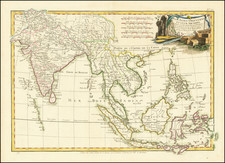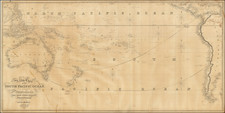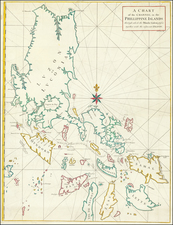American Investment in the Development of the Filipino Lumber Industry.
Important two-piece archive comprising a cyanotype map of the lands owned by two logging companies in northern Negros Island, as well as the passport issued to the president of one of these companies during his tour inspecting the factories.
The map shows the lands owned by the Insular and Negros Philippine Lumber Companies in the vicinity of Cadiz City in northernmost Negros. Located on the northern slopes of Mount Magalagain and Mount Silay, large stratovolcanoes, this heavily forested area, this tropical region contained large amounts of timber resources that were heavily cut down during the early American era through to Philippine independence.
The map is highly detailed, primarily focused on the hydrography for the region. The highest peaks, "Lantawan," "Sicaba dacu," and "Sicaba diutay," are all indicated, these are all part of Mount Silay. In the north, the street grid Cadiz (now Cadiz City) is just about visible, and regional roads are shown.
Accompanying the map is a passport issued for James H. Ramey, president of the Negros Philippine Lumber Company, issued for his return trip to the US after a period spent inspecting the lumber operations in the Philippines. The passport was issued by Francis Burton Harrison, Governor-General of the Philippines from 1913 to 1921, and good for Ramsey's return journey via Hong Kong, China, and Japan.
The Negros Philippine Lumber Company and the Insular Lumber Company
These two lumber companies were heavily involved in the exploitation of Philippine timber in the first part of the 20th century. Lured by extensive timber resources at a time when American supplies were dwindling, they saw the untouched forests of the Philippines as ripe for satisfying the American market.
The Negros Philippine organization was responsible for 60,000 acres of logging land on Negros and produced about 600 million feet of timber at the time of this map's production. The company primarily exported to the United States and England and was continuously setting up new logging mills in the 1910s. The company was situated in Los Angeles, California, and its primary holdings were around Cadiz.
The Insular Lumber Company was a major logging company that operated in the Philippines from the early 1900s until 1976. Headquartered at Fabrica (location of the "Saw Mill" near Paraiso on the map), the company had an outsized influence on the island. The company founded a modern hospital in the area, and its presence continued to draw investment throughout the 20th century, allowing the northern part of Negros to become more developed throughout that period. Following the closure of the company (in part because of dwindling timber), the company has retained a disproportionate importance in the popular conscience. Many refer to the "ILCO" as the largest lumber company and sawmill in the world, although we were unable to find supporting evidence for this claim.
James H. Ramey
James Ramey was president of the Negros Philippine Lumber Company at the time when this archive was made. Based in Los Angeles, he made repeated trips to the Philippines to check on lumber operations there, as well as trips to the Pacific Northwest and other important logging regions.
A mention is made of the trip Ramey made for which this passport and map were made, in the 1913 edition of the Timberan, which reads as follows:
James H. Ramey, of Los Angeles, and J. Calyton Niebels, president and general manager, respectively, of the Negros-Philippine Lumber Co., from the company's concessions in Northern Negros. Mr. Ramsey expects to remain in the Philippines for some time before returning to his home in the United States. J. C. Nichols states that a new 150 H.P. engine was put in their mill last month for driving the head saw, while the other engine will be used for the other machinery. The company is about one month ahead on their railroad grading.
A Brief History of the Philippino Timber Trade
Timber production in the Philippines was almost solely dedicated for domesticate use as late as the latter half of the 19th century. During this period of Spanish rule, all trade occurred through Manila, with ship captains buying the wood and reselling it themselves in a highly inefficient market. Sawmills and other industry uses were all concentrated in Manila.
The American period saw a rapid increase in the development of the Philippino processing capabilities, which had been started to a very limited extent during the late Spanish period. By 1903, Manila had fifty-seven small sawmills, but this was still primarily targeting a domestic market to satisfy a growing city.
By the 1910s, American companies were building sawmills throughout the archipelago, with the Negros Philippine and Insular Companies at the forefront. The American market was very dependent on Philippino hardwoods, in particular the mahogany. The islands were notable for the many different types of forests that grew, ranging from pine to tropical, which depended on latitude and elevation. Philippine production of timber continued to be important until the 1970s and 80s when the resources were too heavily depleted to keep exploiting and the government passed environmental legislation.













![[ Philippine Islands ] This Pocket Map of Philippine Islands...](https://storage.googleapis.com/raremaps/img/small/94096.jpg)
![[Philippine Islands, Taiwan, etc] Partie des Isles Philippines; Partie de la Chine; Partie de L'Ile Gilolo; Partie de L'Isle Borneo](https://storage.googleapis.com/raremaps/img/small/93579.jpg)

